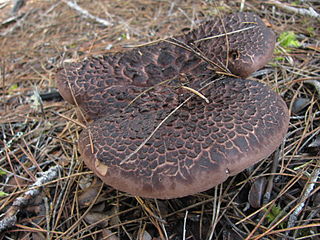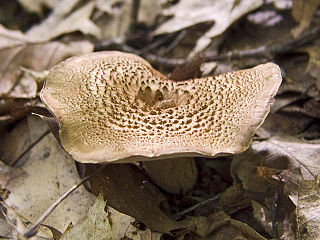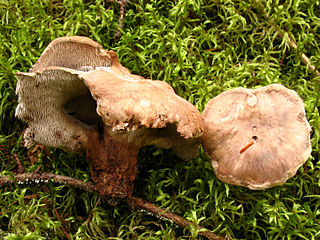
Sarcodon is a genus of fungi in the family Bankeraceae, which is part of the order Thelephorales known for its almost universal ectomycorrhizal life style. The genus owes its name to the presence of teeth-like spines on the hymenophore, it is derived from ancient Greek; sarco = flesh and odon = tooth. This is why they are commonly called "tooth fungi", or "Hydnoid fungi".
Howard James Banker was an American mycologist. He received his PhD from Columbia University in 1908. Banker was an associate editor of the journal Mycologia starting from its establishment in 1909, until it became the official publication of the Mycological Society of America in 1933. He published several papers in the journal, including a revision of the North American Hydnaceae, which discussed 62 species in 10 genera. Banker died at his home in Huntington, New York, in 1940. The genus Bankera is named after him.

Sarcodon squamosus is a species of basidiomycete fungus in the genus Sarcodon.

Sarcodon atroviridis is a species of fungus in the family Bankeraceae found in North America and Asia. It was originally described in 1895 as Hydnum atroviride by Andrew Price Morgan. Howard James Banker transferred it to Sarcodon in 1906. The fungus is known from Asia and North America; in 2015 it was reported from Brazil. The specific epithet atroviridis means "blackish green". While not explicitly known to be poisonous, it is considered of poor edibility.
Hydnellum rickeri is a tooth fungus in the family Bankeraceae. Found in North America, it was described as new to science in 1913 by mycologist Howard James Banker from collections made in Orono, Maine. It is named after botanist Percy L. Ricker, who collected the type specimen. Fruit bodies are dingy brown to olive-colored, and have a strong, spicy odor that persists after they have dried.

Hydnellum underwoodii is an inedible species of tooth fungus in the family Bankeraceae. Found in North America, it was described as new to science in 1906 by American mycologist Howard James Banker. Its reddish-brown, convex to flattened cap measures 5–14 cm (2.0–5.5 in) in diameter. Reddish-brown, partially erect scales adorn the cap surface. Spines on the cap underside are 1–3 mm long; they are initially white, becoming brown with grayish tips in age. The oval to spherical spores are 6–7.5 by 5.5–6.5 µm. The fungus fruits singly or scattered, on the ground in coniferous forests.

Sarcodon stereosarcinon is a species of tooth fungus in the family Bankeraceae. Found in North America, it was described as new to science in 1940 by mycologist Lewis Edgar Wehmeyer, who found the original collections in Nova Scotia, Canada.
Sarcodon pakaraimensis is a species of tooth fungus in the family Bankeraceae. Found in Guyana, where it grows in mixed Pakaraimaea–Dicymbe forest, it was described as new to science in 2015. It is differentiated from other Sarcodon species by its smooth to pitted, pinkish-gray cap that stains black, its hollow stipe, and the pink staining reaction of injured flesh. Its spores measure 5–7 µm long by 5–9 µm wide. They make a fresh dark reddish-brown spore print, which tends to lighten to yellowish brown when it is dry. Molecular analysis of DNA sequences shows the fungus to be closely related to S. umbilicatus. The specific epithet pakaraimensis refers to the Pakaraima Mountains—the type locality.
Sarcodon harrisonii is a species of tooth fungus in the family Bankeraceae. Found in the southeastern United States, it was described as new to science in 1985 by Richard Baird. The type collection was made near Asheville, North Carolina. The fruit body has a flattened cap up to 17 cm (6.7 in) wide with a leathery surface texture that is reddish brown to dark brown. Spores are more or less spherical, measuring 7–8 by 6–7.5 µm. S. harrisonii is similar in appearance to the Michigan species S. ustalis. The specific epithet honors Canadian mycologist Kenneth A. Harrison for his work on stipitate hydnums.

Sarcodon rimosus, commonly known as the cracked hydnum, is a species of tooth fungus in the family Bankeraceae. Found in the Pacific Northwest region of North America, it was described as new to science in 1964 by mycologist Kenneth A. Harrison, who initially called it Hydnum rimosum. He transferred it to the genus Sarcodon in 1984. Fruit bodies of S. rimosum have convex to somewhat depressed caps that are 4–12 cm (1.6–4.7 in) in diameter. The surface becomes scaly in age, often developing conspicuous cracks and fissures. It is brown with violet tints. The flesh lacks any significant taste and odor. Underneath the cap cuticle, the flesh turns a bluish-green color when tested with a solution of potassium hydroxide. The brownish-pinks spines on the cap underside are typically 2.5–7 mm long, extending decurrently on the stipe. Spores are roughly spherical with fine warts on the surface, and measure 5–6.5 by 4.5–5 µm. The hyphae do not have clamp connections.
Sarcodon lanuginosus is a species of tooth fungus in the family Bankeraceae. It was described as new to science in 1961 by mycologist Kenneth A. Harrison, who initially called it Hydnum lanuginosum. He transferred it to the genus Sarcodon in 1984. It is found in Nova Scotia, Canada, where it fruits on the ground singly or in groups under spruce and fir. The type collection was made in Cape Split, Kings County.
Sarcodon cyanellus is a species of tooth fungus in the family Bankeraceae. Found in the Pacific Northwest region of North America, where it associates with Pinaceae, it was described as new to science in 1964 by mycologist Kenneth A. Harrison, who initially called it Hydnum cyanellum. He transferred it to the genus Sarcodon in 1984. It has a vinaceous-violet to bluish-black cap.

Sarcodon calvatus is a species of tooth fungus in the family Bankeraceae. It was described as new to science in 1964 by mycologist Kenneth A. Harrison, who initially called it Hydnum calvatum. He transferred it to the genus Sarcodon in 1984. It is found in North America.

Hydnellum martioflavum is a species of tooth fungus in the family Bankeraceae, found in Europe and North America.
Sarcodon wrightii is a species of tooth fungus in the family Bankeraceae. It was first described in 1860 by Miles Berkeley and Moses Ashley Curtis as Hydnum wrightii. They were sent a specimen collected from Japan as part of the North Pacific Exploring and Surveying Expedition (1853–56). Rudolph Arnold Maas Geesteranus transferred it to the genus Sarcodon in 1967. The fungus produces roughly spherical spores that are tuberculate and measure 5.5–6.5 by 4.5–5.5 μm.
Sarcodon excentricus is a species of tooth fungus in the family Bankeraceae. The fungus was originally described in 1951 by William Chambers Coker and Alma Holland Beers. The type collection was made by Lexemuel Ray Hesler in Cades Cove, Tennessee in 1937. Coker and Beers did not include a description of the fungus written in Latin—a requirement of the nomenclatural code at the time—and so their new species was not validly published. Richard Baird published S. excentricus validly in 1985.
Sarcodon scabripes is a species of fungus in the family Bankeraceae found in Asia, Europe, and North America. It was originally described in 1897 as Hydnum scabripes by Charles Horton Peck. Howard James Banker transferred it to the genus Sarcodon in 1906. The fungus makes fruit bodies with a drab gray to flesh-colored cap, and flesh that is white. In addition to the United States, where it was first documented, S. scabripes has been reported from Japan and the Sverdlovsk Oblast region of Russia.

Hydnellum versipelle is a species of tooth fungus in the family Bankeraceae. It was originally described by Elias Fries in 1861 as Hydnum versipelle. Taisiya Lvovna Nikolayeva transferred it to the genus Sarcodon in 1961. Hydnum crassum, published by Kenneth A. Harrison in 1961, is a synonym. The species is found in Europe and North America.
Sarcodon subfelleus is a species of tooth fungus in the family Bankeraceae. It was described as new to science in 1961 by mycologist Kenneth A. Harrison, who initially called it Hydnum subfelleum. He transferred it to the genus Sarcodon in 1984. It is found in Nova Scotia, Canada, where it fruits on the ground singly or in groups under spruce and fir. The type collection was made in Glenmont, Kings County.
Sarcodon ustalis is a species of tooth fungus in the family Bankeraceae. It was described as new to science in 1964 by mycologist Kenneth A. Harrison, who initially called it Hydnum ustalie. He transferred it to the genus Sarcodon in 1984. It is found in Michigan, where it fruits on the ground in groups under Jack Pine. The type was collected by Ingrid Bartelli in Marquette, Michigan.








